You’re on your hiking trail, and it’s cold and raining. To continue longer, you need to combat the tough weather challenges, and there’s nothing better than sitting beside a campfire. But hold on! Can you have a Bonfire in the rain while hiking? Well, It’s going to be tough, but we’ve got you covered.

In this article, we will walk you through what tools you’d need, how you’re going to use those tools to pile up resources, and finally, how to set up those resources to build a campfire.
Additionally, we have some bonus tips to increase your chances of successfully having a bonfire under wet weather conditions. So, let’s start.
Quick Answer: Can You Have a Bonfire In the Rain?
Yes, you can. The most Ideal weather conditions for bonfires are when it’s dry and sunny. In contrast, damp and moist environments can give you a tough time. But this also comes with its own adventures. With learning and patience, every new hiker can hone this great survival skill.
Dry wood and dry land are probably the basic requirements to start over. While this is something that you’re to build on your own in a wet environment. To help you through, there should be a wise selection of camping tools and basic materials for igniting a fire in your backpack.
Later, the ball is in your court. Whether you need a fire to cook or get some warmth, the type of campfire should be chosen accordingly. However, fueling your campfire timely is a factor that shouldn’t be overlooked to sustain longer.
Table of Contents
Can You Have a Bonfire In the Rain With Wet Wood?
Burning wet wood without processing isn’t a great fuel for campfires. The more moisture from the inside, the harder it gets to catch fire. It is because water and fire show resistance in each other’s presence.
However, some tricks for starting a fire with wet wood can bring you success. The most common is to find hung-up barks, which aren’t laid onto the ground to soak up water.
Also, some species, such as Birch and Maple, absorb less water than others. The inside of these woods is dry and brittle. Therefore, they can be used after their outer barks are peeled off.
Can You Ignite Fire With Dry Wood?
Typically, the dried dead woods are the best for bonfires. You can still find them easily, even during persistent rainfalls.
Look around you. Can you see tall, standing trees that have no greens and either with or without limbs or branches? Also, you can find dead lower branches near the trunk of heavily grown green trees. Some more broken tree limbs that are tangled in other branches and couldn’t make it to the ground.
Keep collecting fire-igniting materials as you hike through the landscapes so you won’t have to rush at the last minute.
What Things You Should Have to Bonfire in the Rain
When hiking in forecasted conditions, it’s wise to have or find supplies for the bonfire. Here are 4 key elements you’ll need for lighting a campfire.
#1 – Tinder
Making tinder is the first element for building up heat to start a fire. These are basically the coals of a campfire. It can either be home-based or natural tinder found on a campsite.
Some commonly used tinders are:
- Fluffed cotton balls.
- Shredded cardboard boxes.
- Dry grass and twigs
- Dead pines.
- Small wood shavings.
- DIY feather sticks.
#2 – Kindling

Kindlings are smaller wooden barks that are put next to tinder. Ideally, these should be from softwood. A good size kindling shouldn’t be thicker than half an inch and length up to 5 to 8 inches.
#3 – Firewood
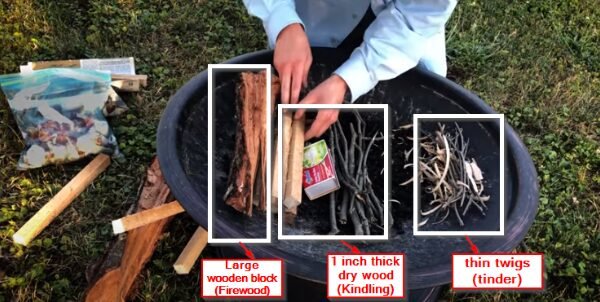
Larger wood logs make firewood, which is used as fuel over the kindling. The larger logs are first split open to expose the dry interior of the woods before getting into the fire.
As they are generally the hardwoods. Therefore, it can help your fire sustain longer by taking more time to burn, while the necessary heat is provided by tinder and kindling.
#4 – Firesteel
Within damp conditions, a fire steel can help ignite the tinder faster. These waterproof firelighters produce sparks when rubbed against the knife’s spine.
If there are forecasted conditions, make sure to carry fire steel with you while hiking, but even if you don’t have one, you can make frames to ignite the fire while raining. We’ll explain how to make frames to build a campfire below.
How Can You Have a Bonfire In The Rain? -7 Quick and Easy Steps
Now that you’ve got the right material. Here are the seven simple steps to build a bonfire on a rainy hike. Follow each step thoroughly, and you’ll have your campfire ready in no time.
Step#1: Choose the Right Location

Choosing the right spot will determine the success of building and maintaining your fire. Water and wind can be the two major obstacles on your way here.
If you’re standing in a dense forest, consider a spot where the tall standing trees are forming a natural canopy. This will shelter your fire from a good amount of rain pouring down.
Also, make sure that there should be no overhanging branches and brushes nearby to catch fire. However, if you’re on a landscape with no trees, place your tarp where it leans against the flow of winds.
Step#2: Clear Your Fire Pit
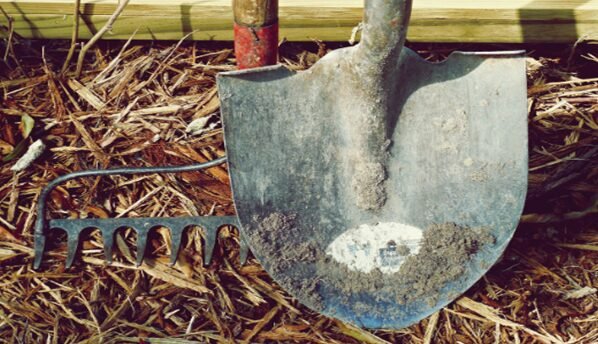
Once you’ve chosen the right spot, it’s time to clear space for your fire pit. First, mark the size of your pit on the ground with the edge of a shovel. Now remove the brushes, leaves, and dry grass from the surface area.
After scraping off the first layer, dig around a 12-inch deep pit that should be hollow from the center.
Step#3: Construct the Perfect Floor For the New Fire
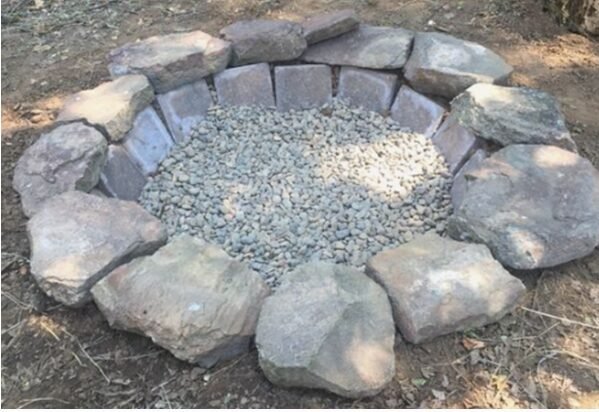
Once you’ve cleared the firepit, it’s time to prepare the area to start kindling. The moisture content in the ground could hinder your process of making fire. So, to avoid this, make sure your tinder isn’t placed directly on the ground.
You can use a base layer of paving stones or any fireproof material. This safety layering can also prevent ground fires from spreading.
Step#4: Make the Right Frame for Fire
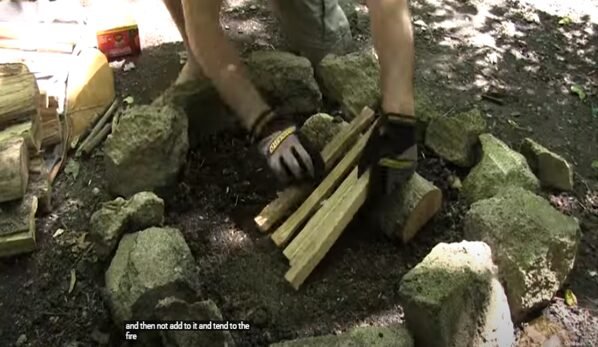
Now, create a structure on which you want to light your fire up. Your purpose for the bonfire and the material in hand determines the type you should go for.
For beginners, it’s ideal to go for frames that support small fires that are easy to build and maintain. Amongst them, Lean-to and A-frames can be quickly made with less effort and resources.
Gather your resources, sort your woods into sizes, and start building with smaller ones, as they are easy to catch fire.
A-frame Bonfires

The fire within these frames rises up vertically. Although these aren’t very hot, they can be excellent for keeping your body warm. You can even use them for cooking once the fuel wood over the fire collapses.
Follow these simple steps to create an A-frame:
- Set a frame with three kindling sticks such that it forms an A.
- Start placing the kindling sideways, but don’t place them too close as it will affect the flow of oxygen needed for combustion.
- Cover only two sides, leaving the front as a gateway to feed tinder, such as weeds and dried bark.
Lean-to Frames Bonfires

Another starter campfire design is the lean-to frame. The lean-to-fire is a preferable campfire choice in windy regions due to its air-blocking design. Since the flames are low to the ground, hikers can have fun cooking over the slow-glowing embers.
The below steps could help to create lean-to frames in minutes:
- Place a large wood log in the direction of the wind. This will act as a windbreaker to the frame.
- Place the bunch of loosely bonded tinder beside the wood log.
- Now it’s time to lean on kindling sticks over the wood log covering the tinder down to the ground.
Step#5: Now It’s Time For Building the Roof
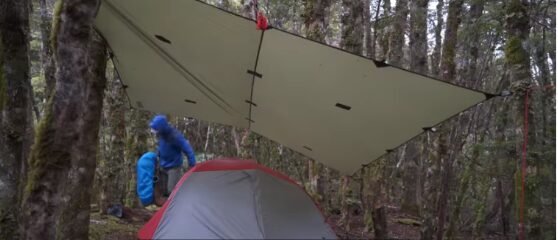
You need enough shelter from rain and wind to uphold a long, burning fire. Spreading Tarps over the campfires can help you provide a suitable environment for setting and maintaining your fire outdoors.
However, you should only carry ones that are fire and water-resistant. Once you’re up with the right pick, you need to install it properly. Make sure the height of your tarp above your campfire is well-adjusted.
Take added precautions, such as tying up your tart diagonally. The higher end should be at your campfire side, and the low-hanging one should rest slightly above your camp. This position helps release smoke from a bonfire.
Also, ensure that the tarp maintains a distance from overhanging bushes to avoid any fire contact.
Step#6: Light Your Pit
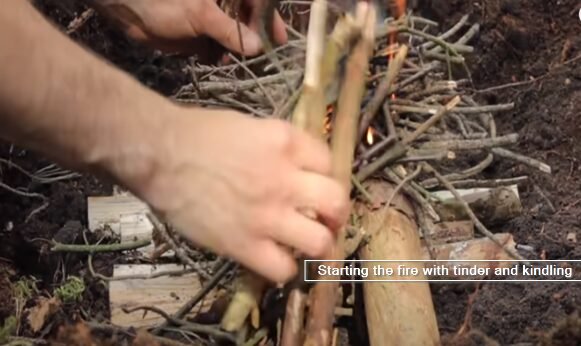
In previous steps, we’ve done building a frame for our fire. Now it’s time to ignite the tinder. Collect your tinder and form a fluffed ball of it using your hands. Now, hold a Ferro rod and rub it against your knife. You can also use a firesteel to ignite a fire within seconds.
Throw sparks onto the tinder until it starts heating, and the fire lits up. Remember, A-frame? This burning tinder will go beneath the kindling woods from the opening in front of the A-frame.
Step#7: Keep Feeding The Fire So It Stays Dry

Don’t put loads of kindling to burn at once. Rather, add layer by layer. Ignite fire from smaller kindling first. Keep adding smaller wood barks to raise the flames.
Once there’s enough heat to catch up, feed your fire with large logs, which we call firewood. Be careful while positioning the firewood, as the moisture from the wood can derail your fire-making process.
Place them in a way that the dry interior walls show off directly to the fire. While the outermost bark faces outwards.
How Can You Have a Bonfire In The Rain- 3 Bonus Tips
Start the Fire Under a Covered Area
To keep the fire going, you need a cover. So, can you put a tarp over a campfire? Well yes, But it’s only safe with smaller campfires.
Always look for those with fire and water-resistant properties. Furthermore, position them distant from the height of the fire. This way, you can have a friendly and safe experience of having a bonfire while it’s raining.
Use Reflective Material
Using reflective materials like aluminum foil or special blankets near the fire helps to keep the heat in one place. This means the fire stays strong even if it’s raining.
These materials bounce the heat back to the fire so it doesn’t escape too much. They also make a spot where the heat is stronger, which helps to dry out wet wood or things before putting them in the fire.
Pack Snacks and Drinks

Don’t forget to bring snacks and drinks! It’s important to have yummy things to eat and drink while having a fire in the rain. Pick foods that won’t get soggy, like packaged snacks or sandwiches in closed containers.
Hot drinks like hot chocolate or tea can also keep everyone warm and happy. Eating and drinking enough helps everyone enjoy the fire without feeling hungry or thirsty.
How Do You Extinguish the Campfire In the Rain Tarp Before Leaving the Camp?
Letting the fire unattended can be dangerous. Even if the fuel seems completely burnt, the tiny embers can travel through the winds and can grow into massive fires. Always make sure to follow the safety guidelines to extinguish the fire before leaving the campsite.
Step#1: Stop Adding Wood
When you wish to continue a bonfire no longer, stop fueling it an hour before. Once the flames get down, reach out for the next steps.
Step#2: Down the Embers
Pour around 2 full water buckets once you see your kindling has collapsed. If there’s no water nearby, try pouring sand or dirt to smooth out fire flames.
Step#3: Feel For Heat
Embers take a little longer to cool down. That’s why you need to take a close watch by stirring them with a stick. Or bring down your hand over the remaining coals. If you feel the heat, then pour more sand until it cools.
Step# 4: Leave No Trace
Finish off by scrapping all the burnt residue from the surface. Make use of a camping shovel to clean the firepit.
How To Protect Campfire From Rain?- Some Reminders, Before You Go!
- To avoid contact with rain, set a fire-resistant tarp at a distant height above your campfire.
- The strong wind also carries moisture along them. Choose a campfire style that leans against strong wind flows.
- Don’t let your tinder wet by soaking the moisture from the ground. Ignite the tinder over a layer of stones or a bridge formed with wood logs.
- Make use of stones both inside the fire pit and the surrounding area. It absorbs moisture and provides heat to increase the fire’s efficiency.
- A good fire also needs oxygen coming in. Tinder and kindling shouldn’t be nicely packed. To keep the distance, stack up wood pieces 1 to 2 fingers apart.
- Always use dry wood for heating. Wet woods can slow down the heating procedure, so they are better used for fueling the fire. To check if the woods are dry and brittle, snap them with a finger. Also, see if you are able to break them easily and hear the crackling sound.
People Also Ask For
Can you put a tarp over a campfire?
A campfire in the rain tarp can be sustained longer even if it’s wet outside. What you need is to position the tarp carefully so that the nearby spaces might not catch any spark. Also, look for a fire-resistant and waterproof tarp material as a safety precaution.
What are the tricks to starting a fire with wet wood?
Utilize inner bark; it’s often drier than the outer wood and ignites more easily. Choose wood from sap-filled trees, as the sap content aids in igniting damp wood. Begin with smaller wood pieces as they catch fire more easily and help dry out larger logs.
What is the best weather for a bonfire?
In all three seasons, having a bonfire is equally enjoyable. However, the weather conditions should be stable. For example, if there’s more warmth, the sun’s radiation can cause the land to absorb heat, and the fire can grow faster and more ferociously.
Can you put water on a bonfire?
Water can be a great way to extinguish a bonfire. The amount of water needed depends upon the intensity of your fire. It gets easier to put off if you haven’t fueled your fire for an hour.
Is it safe to have a bonfire while hiking in the rain?
Yes, it can be safe if done responsibly. However, precautions should be taken as rain can pose challenges and increase the risk of fire spreading unintentionally.
Campfire In The Rain Tarp- Final Words
So that was all about how can you have a bonfire in the rain. It may seem like a challenge, but with the right preparation and materials, it can be done within minutes.
You just need to find a dry spot, gather some tinder, kindling, and fuel wood, and use a fire starter or matches to ignite the fire. You also need to protect the fire from the rain by using a tarp, a metal drum, or a fire pit. By following these steps, you can enjoy a cozy and warm bonfire even when it’s raining outside.
